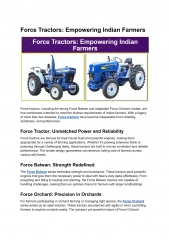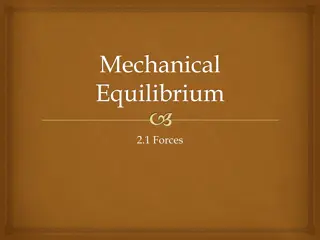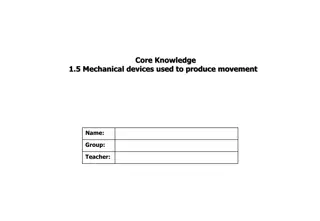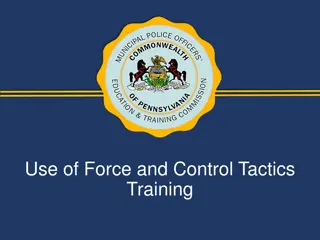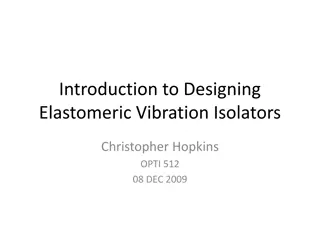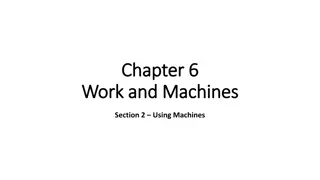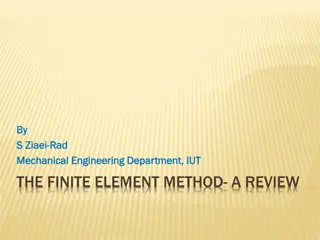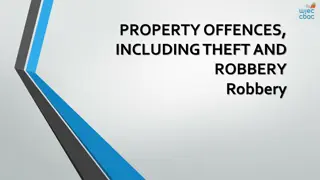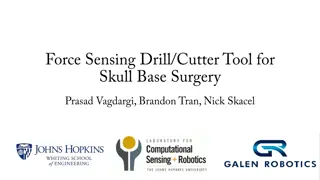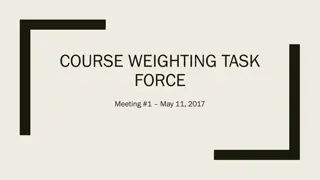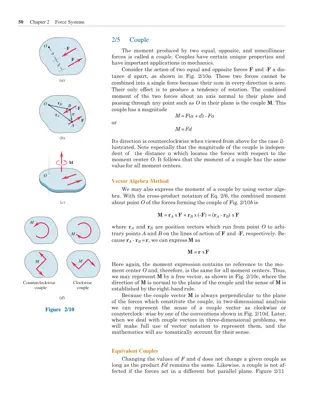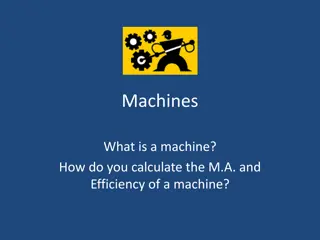Understanding Force Transmissibility in Mechanical Systems
Force transmissibility in mechanical systems is crucial for analyzing the relationship between applied forces and resulting vibrations. This outline covers key concepts such as base excitation, motion transmissibility, and rotating unbalance, providing insights into how forces are transmitted and amplified in different scenarios. Through detailed explanations and numerical examples, the importance of understanding force transmissibility for designing efficient mechanical systems is emphasized.
Download Presentation

Please find below an Image/Link to download the presentation.
The content on the website is provided AS IS for your information and personal use only. It may not be sold, licensed, or shared on other websites without obtaining consent from the author. Download presentation by click this link. If you encounter any issues during the download, it is possible that the publisher has removed the file from their server.
E N D
Presentation Transcript
Outline 1. Force transmissibility 2. Base excitation 3. Motion transmissibility 4. Rotating Unbalance
Forced Transmissibility
Forced Transmissibility Forced Transmissibility In the single degree of freedom system the force transmissibility is defined as the ratio between the magnitude of the transmitted force (ground reaction) and the applied force. F0 Sin ( t) Steady state solution: x xss (t) = X0 Sin ( t - ) Find the force act on the ground at any instant of time t. k c Free body diagram of Ground c k x Spring force Damper force
Forced Transmissibility c k x Spring force Damper force Net force transmitted to ground (FG) = k x + c As time approaches to larger then displacement of mass with respect to time is steady state solution. Therefore x (t)~ xss (t) for larger value of time t . In that case , FG = k xss + c X0 Cos ( t - ) FG = k X0 Sin ( t - ) + c X0 Cos ( t - ) Find the maximum value of FG, ( FG )max = k2 + (c )2 X0 F0 X0 = (k m 2 )2 + (c )2
Forced Transmissibility ( FG )max = k2 + (c )2 F0 (k m 2 )2 + (c )2 Force transmissibility ratio = Maximum force transmitted to ground ( FG )max Maximum amplitude of force acts on mass m (F0) k2 + (c )2 (k m 2 )2 + (c )2 TR =
Forced Transmissibility 1. Find the frequency ratio for which transmissibility ratio is equal to one for any value of damping factor. TR = 1 k2 + (c )2 (k m 2 )2 + (c )2 TR = k2 + (c )2 (k m 2 )2 + (c )2 1 = (k m 2 )2 + (c )2 k2 + (c )2 = (k m 2 )2 + (c )2 = k2 + (c )2 k2 (k m 2 )2 = k m 2 m 2 - k 2k = k k m 2 = = 2k m = 2 n 2 =
Forced Transmissibility numerical 1 An industrial machine of mass 453.4 kg is supported on springs with a static deflection of 0.508 cm. If the machine has a rotating unbalance of 0.2303 kg m, Determine (a) the force transmitted to the floor at 1200 rpm and (b) the dynamical amplitude at this speed. (X0) (Assume damping to be negligible.) F0 Sin ( t) F0 = m e 2 x Unbalance force = mass x eccentricity = 0.2303 kg m Speed of engine N = 1200 rpm k c Angular velocity of engine = (2* pi() * N) / 60 ( FG )max = k2 + (c )2 F0 (k m 2 )2 + (c )2 K = mg static deflection Force transmitted to ground
Base excitation Consider a spring mass damper system subjected to ground motion y(t). Let x(t) is represents displacement of mass m. x(t) o Draw free body diagram of mass m. m A Assume x > y k c y(t) if x > y then spring is stretched by ( x - y) B Spring force = stiffness * elongation in spring = k * ( x- y) c ( - ) k( x- y) Damper force = damping coefficient * relative velocity VA/B = c * (velocity of A velocity of B) = c * ( - ) (velocity of A = & velocity of B = ) m
Base excitation ?0 = ? y0 2 ? ? + ? ? + ?? = ?0Sin ( t) c ( - ) k( x- y) ?????? ????? ???????? m ? ? = ?0 Sin ( t - ) From Newton second law of motion, ?0 Z0 = m = - k ( x y) c ( - ) (k m 2 )2 + (c )2 Assume x - y = z c tan ( ) = k m 2 - = z ? ? = ? ? ?(?) ? ? + ? = ?? ? ? ? ? = ? ? + ?(?) ? ? = ?0 Sin ( t ) + y0 Sin ( t) ? ? + ? ? + ?? = ? ? Find the maximum value of x(t) . let y(t) = y0 Sin ( t) X max = X0 ? ? + ? ? + ?? = ? y0 2 Sin ( t)
Base exicitation 1. An undamped vibration pick- up having a natural frequency of 1 Hz is used to measure a harmonic vibration of 4 Hz. If the amplitude recorded is 0.52 mm, what is the correct x(t) amplitude? m Given natural frequency of spring mass, fn = 1 Hz. Frequency of base excitation, f = 4 Hz A k c y(t) Amplitude recorded, Z0 = 0.52 mm Correct amplitude, Xo = ?? B y(t) = y0 Sin ( t) For undamped vibration pick up means , y0 2 damping coefficient c is equal to zero. ?0 = 0.4875 mm Z0 = Mode( 2n 2 ) ? y0 2 Z0 = y0 (2 3.14 4)2 0.52 = (k m 2 )2 + (c )2 Mode(2*3.14*1)2 (2*3.14*4)2 ) ? y0 2 Mod((k m 2 )) ?0*16 Z0 = 0.52 = 15
Base exicitation ?0 = 0.4875 mm ? ? = ?0 Sin ( t ) + y0 Sin ( t) ? ? = 0.52 Sin ( t ) + 0.49 Sin ( t) = 2*3.14*4 = 25.1 rad/s ? tan = k m 2 = 1800 = 00 ? ? = 0.52 Sin (25.1 t) + 0.49 Sin (25.1t) ? ? = 0.52 Sin (25.1 t) + 0.49 Sin (25.1t) ? ? = 0.52 Sin (25.1 t) + 0.49 Sin (25.1t) ? ? = 1.01 Sin (25.1 t) ? ? = 0.03 Sin (25.1 t) = 0.03 X0 X0 = 1.01
Motion transmissibility
Rotating unbalance o Rotating unbalance is the uneven distribution of mass around an axis of rotation. o A rotating mass, or rotor, is said to be out of balance when its center of mass (inertia axis) is out of alignment with the center of rotation (geometric axis). o Unbalance causes a moment which gives the rotor a wobbling movement characteristic of vibration of rotating structures. Y o C is geometric center of rotor. o G is center of mass of rotor. e G X C o CG is called as eccentricity. and it is denoted as e . CG = e
Rotating unbalance Y Consider rotor rotates with angular velocity in anticlockwise direction. At in instant of time CG vector make an angle with horizontal axis. Fc G If m is mass of rotor then centrifugal force Act on the rotor is equal to. X C Fc = m e 2 Direction of centrifugal force is along CG Vector (radially outward direction) Direction of centrifugal force change with time. Due to this dynamic force unbalanced Force is generated in machine. Generally unbalance is given in term of Mass x eccentricity (kg-m)
Rotating unbalance Rotor Fc Fc G G C G Rotor M = mass of the rotor (kg). Locus of center of mass of rotor. CG = eccentricity e (m). = angular speed of shaft or rotor (rad/s) Fc = centrifugal force (N). Fc = mass of rotor x eccentricity x (angular velocity)2 Fc = m x e x 2 m x e = unbalance (kg-m)


